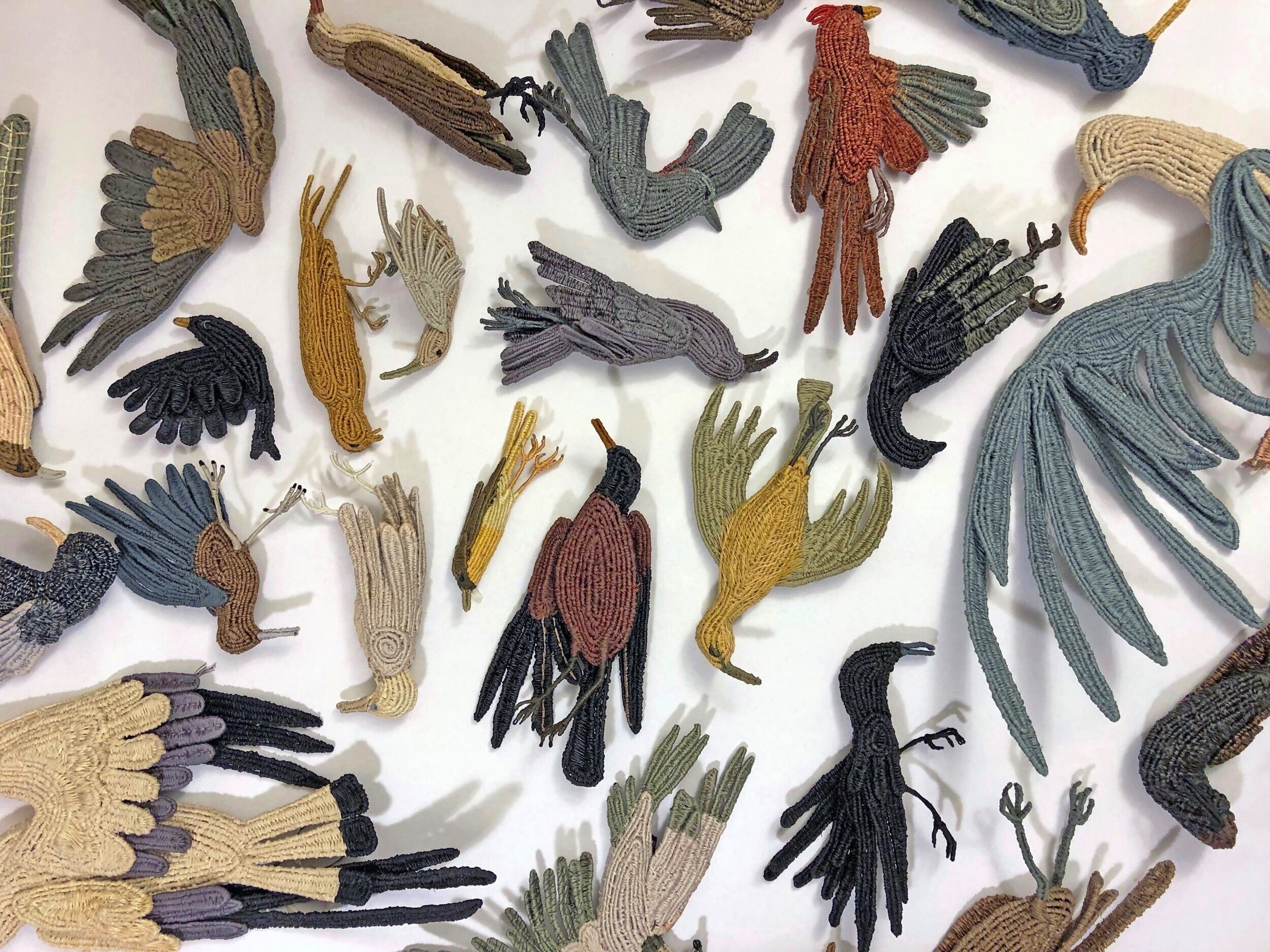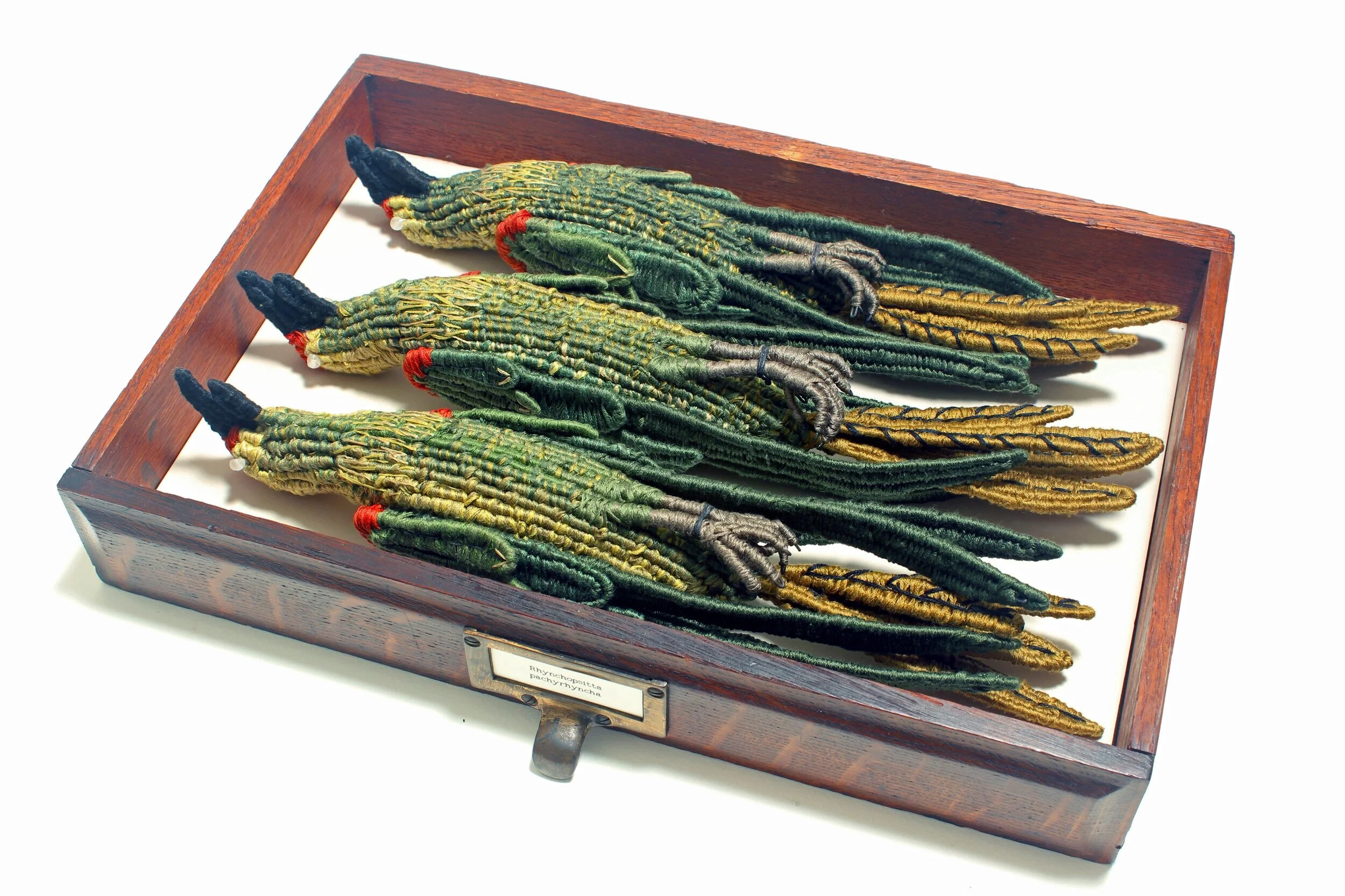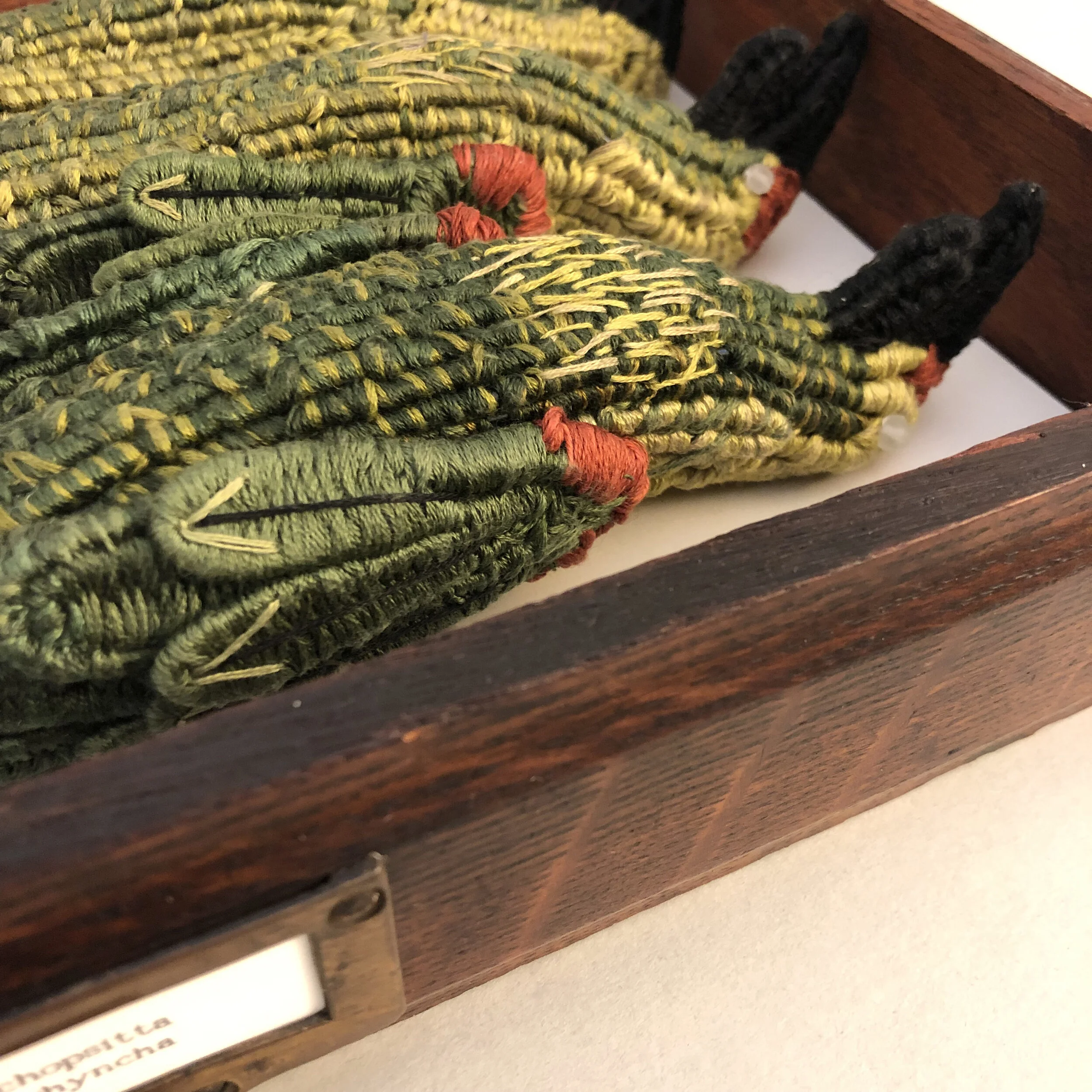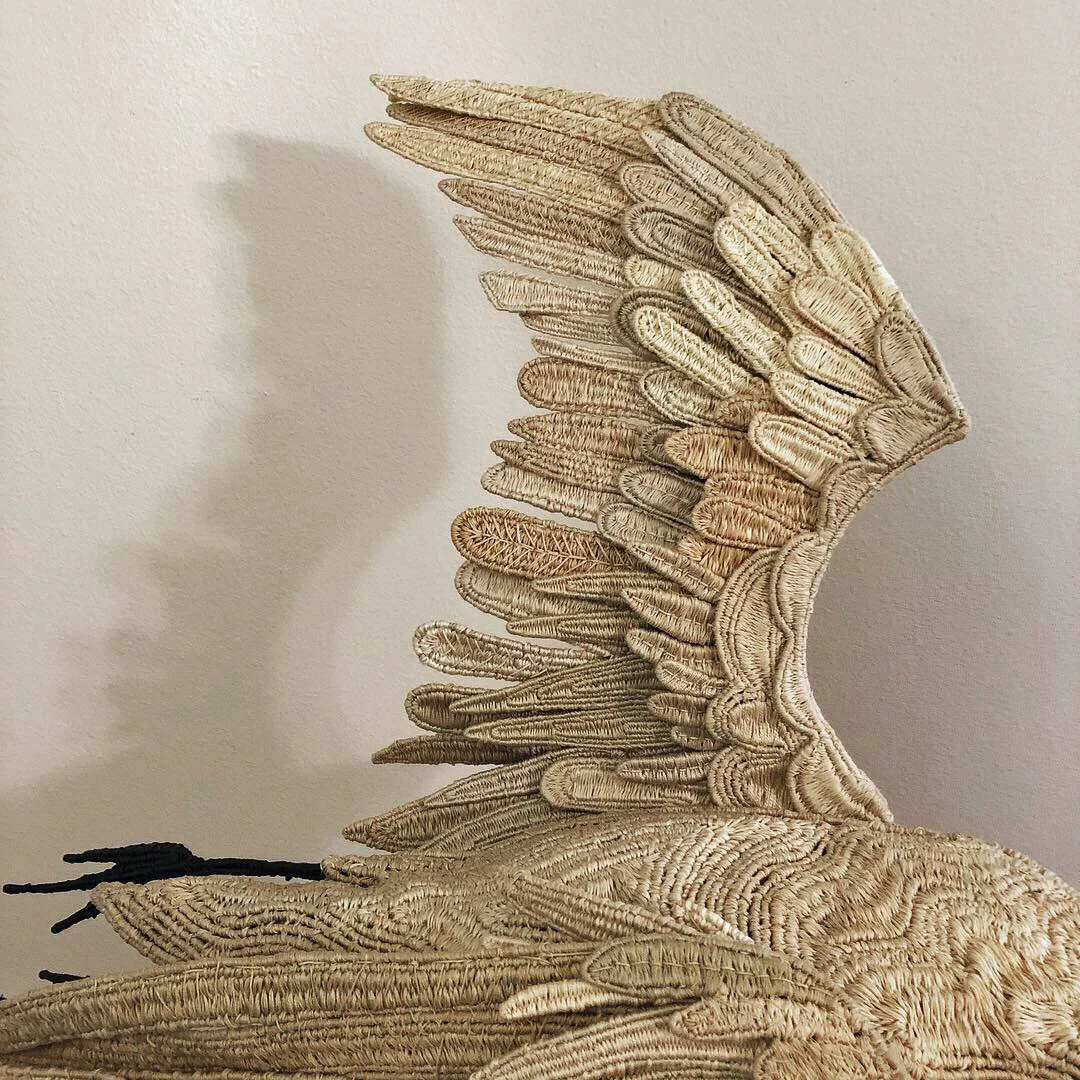Carol Eckert employs a simple basketry technique, coiling, to construct a myriad of forms referencing the complex interactions of humans with the natural world. With inventive adaptations of this ancient process, she creates vessels, staffs, books, wall pieces, and installations — all engaged with the universal nature of animal symbolism.
Among Eckert’s exhibitions are Rooted, Revived, Reinvented: Basketry in America, a three-year traveling exhibition; Game Changers: Fiber Masters and Innovators, Fuller Craft Museum, Brockton, Massachusetts; and 14th International Triennial of Tapestry, Lodz, Poland. Her work can be found in a number of permanent collections, including Arizona State University Art Museum, Tempe, Arizona; Denver Art Museum, Colorado; de Young/Fine Arts Museums of San Francisco, California; Erie Art Museum, Pennsylvania; Fuller Craft Museum; Mint Museum of Craft + Design, Charlotte, North Carolina; Museum of Arts and Design, New York City; Museum of Fine Arts, Boston; Philadelphia Museum of Art, Pennsylvania; Racine Art Museum, Wisconsin; and Renwick Gallery, Smithsonian American Art Museum, Washington, D.C.
In addition to her studio practice, Eckert lectures, publishes a daily blog on contemporary basketry, and works as an independent curator.
For more information, please see: caroleckert.com and on Instagram @caroleckertart.
Carol Eckert, Memento Mori: The 100 Dead Birds Project, 2019 - ongoing. Cotton, linen, wire. Dimensions variable. Image courtesy of the artist.
Exhibition view. Image courtesy of the artist.
It's my experience that most artists engage with some level of self-isolation in their day to day art practice. Has this been your experience? And if so, have you found these innate rhythms to be helpful during this larger, world-wide experience of isolation?
My day-to-day practice has barely changed. I’m a studio rat by nature and my workspace is at home. I’m keeping my regular schedule, which is an early morning start, with office tasks first. I publish a daily blog on contemporary basketry, so I begin each day researching. My definition of basketry is broad and it’s always exciting to discover new artists across the globe. Then I get started in the studio, where I usually work till 7 or 8 each evening.
Even though I work in isolation, I don’t feel isolated because I’m connected to so many people through Instagram and Zoom. Instagram became part of my practice in 2019 when I started Memento Mori: The 100 Dead Birds Project. I asked people to DM images of dead birds and I’ve constructed nearly 100 so far. The most recent image was a woodpecker found near the main station in Cologne. My piece brings attention to humankind’s impact on birds, and while it was on exhibit recently, research was published documenting more than 3 billion birds in North America lost due to climate change and pollutants, so I plan to keep going indefinitely. I hope I’ll be able to exhibit it again because visitors to the exhibition also sent me images, and then were able to return to see their birds added to the installation.
Carol Eckert, The Last Parrots, 2019. Cotton, linen, wire, with found drawer. 14.5 x 9.5 x 3”. Image courtesy of the artist.
How are you doing? How are you navigating the highs and lows?
As the pandemic drags on, I’m feeling down about the sameness of each day. I’m missing my spread-across-the-country family and traveling. But I work with an artist relief organization, so I also know that many artists are facing much worse circumstances.
I’m limiting my news intake so I don’t get sucked into a despair vortex. I set a Google Arts & Culture bookmark, so when I’m tempted to check for New York Timesupdates, I click there instead. It does have its own pitfalls, because I can find myself walking though a botanical garden in Brazil and realize an hour has passed.
Carol Eckert, The Last Parrots (detail), 2019. Cotton, linen, wire, with found drawer. 14.5 x 9.5 x 3”. Image courtesy of the artist.
It would be great if you could briefly talk us through your practice.
The universal nature of animal symbolism appeals to me: snakes as symbols of evil, storks or cranes as signs of good fortune, ravens and crows as portents of doom. I’m fascinated by parallel mythologies existing across cultures, such as the story of a great flood, common to civilizations from Mesopotamian to Aztec, from Norse to Aboriginal. I am intrigued that societies from so many different times and places share related traditions and cultural memories.
My studio shelves are filled with art and mythology texts, poetry collections and natural history chronicles, antique volumes of Aesop’s fables and reproductions of medieval bestiaries. Creation stories, tales of journeys and quests, parables of good and evil, prophecies of transformation—these are the stories that have found their way into my work, not as specific narratives, but as references to the connections between people across continents and centuries, and to the natural worlds they inhabit.
Carol Eckert, Swan Still Life, 2019. Cotton, linen, wire, with found pedestal. 53 x 28 x 20”. Image courtesy of the artist.
Has any of your imagery shifted in a reflection to what's currently happening? And why, or why not?
I’ve employed bird imagery frequently and I’m intrigued by the bird symbolism of so many cultural traditions. Mythology has always been an important source for my work, especially as it reflects humankind’s relationship to the natural world. As I grow increasingly worried over our abuse of the earth, my work is becoming darker, with ancient myths giving way to influences from 17th century paintings of dead game, 18th century cabinets of curiosity, and 19th century natural history museums — humans’ ancient reverence for nature replaced by an assumption of dominion over the earth.
Carol Eckert, Swan Still Life (detail), 2019. Cotton, linen, wire, with found pedestal. 53 x 28 x 20”. Image courtesy of the artist.
Are you reading anything?
Fascinated by the thousands of bird skins collected in natural history museums, I began a series of works based on specimen drawers. I researched the development of natural history museums, and now I’ve begun to think more deeply about all museums. I’m currently working on a wall piece influenced by early cabinets of curiosities and reading the biography of Hans Sloane, whose collections founded the British Museum. It’s interesting but also distressing, since he became wealthy from the work of enslaved people, and his huge collections were full of dead and looted things.
When I need something escapist, I listen to vintage detective stories.
Carol Eckert, Still Life With Heron, 2019. Cotton, linen, wire, wood. 20 x 31 x 12”. Image courtesy of the artist.
What is bringing you solace, or even joy, in this moment?
I’m thankful for the sense of community that’s been intensified by these times and for the way so many in our field have joined together virtually to share and collaborate. It gives me hope for the future.
Carol Eckert, The Fall of Icarus, 2020. Cotton, linen, wire, leather, encaustic. 6 x 79 x 38” (floor piece). Image courtesy of the artist.








